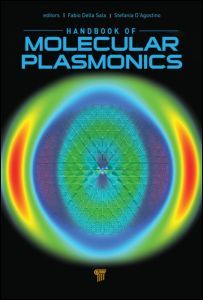Handbook of Molecular Plasmonics
Coordonnateurs : Sala Fabio Della, D'Agostino Stefania

While several reviews and books on surface nanophotonics and fluorescence spectroscopy are available, an updated focus on molecular plasmonics, including both theoretical methods and experimental aspects, is still lacking. This handbook is a comprehensive overview on the physics of the plasmon?emitter interaction, ranging from electromagnetism to quantum mechanics, from metal-enhanced fluorescence to surface-enhanced Raman scattering, from optical microscopy to synthesis of metal nanoparticles, filling the gap in the literature of this merging field. It allows experimentalists to have a solid theoretical reference at a different level of accuracy, and theoreticians to find new stimuli for novel computational methods and emerging applications.
Foundations of Molecular Plasmonics. Computational Approaches for Plasmonics. Size and Shape Dependence of Localized Surface Plasmon Resonances. Computational Molecular Photophysics. Metal-Molecule Electrodynamic Coupling. Near-Fields in Assembled Plasmonic Nanostructures. Noble Metal Nanostructure Enhancement of Fluorescence. Surface-Enhanced Raman Scattering. Parabolic Mirror-Assisted Gap-Mode Optical Ultramicroscopy. Synthesis Techniques for Colloidal Plasmonic Nanostructures.
Fabio Della Sala received his PhD in electronics engineering from University of Rome "Tor Vergata," Italy. He leads the theoretical and computational division of the National Nanotechnology Laboratory of CNR (Lecce), Italy. He is an expert in density functional theory methods, computational material science, organic and inorganic optoelectronics, and computational nanoplasmonics. In these research fields, he has authored more than 120 publications. In 2007, he was awarded the European Research Council Starting-Grant.
Stefania D’Agostino received her PhD in nanoscience from the ISUFI School, University of Salento, Italy. Her research interests include computational solid-state physics, nanoscience, photonics and molecular plasmonics. She is author of several publications in international journals. In 2010, she obtained a fellowship at the National Nanotechnology Laboratory of CNR, Lecce, Italy, and in 2011, a postdoc position at the Physics Department "A. Volta" of the University of Pavia, Italy.
Date de parution : 08-2013
Ouvrage de 450 p.
15.2x22.9 cm
Thèmes de Handbook of Molecular Plasmonics :
Mots-clés :
American Chemical Society; Molecular Plasmonics; Foundations of Molecular Plasmonics; Metal Nanoparticles; Surface-Enhanced Raman Scattering; Dielectric Constant; Synthesis Techniques for Colloidal Plasmonic Nanostructures; Dielectric Function; Near-Fields in Assembled Plasmonic Nanostructures; Transition Dipole Moment; Computational Molecular Photophysics; Raman Spectrum; DDA Simulation; Copyright American Chemical Society; Au Nanorods; Cos Θi; PVP Polymer; Au Nanowire; SERS Spectrum; LSPR Shift; Localized Surface Plasmon Resonances; SERS Activity; TEM Image; LSPR Frequency; SERS; Non-radiative Decay Rate; Au NCs; ISC; Scattering Spectra; Tip Apex



